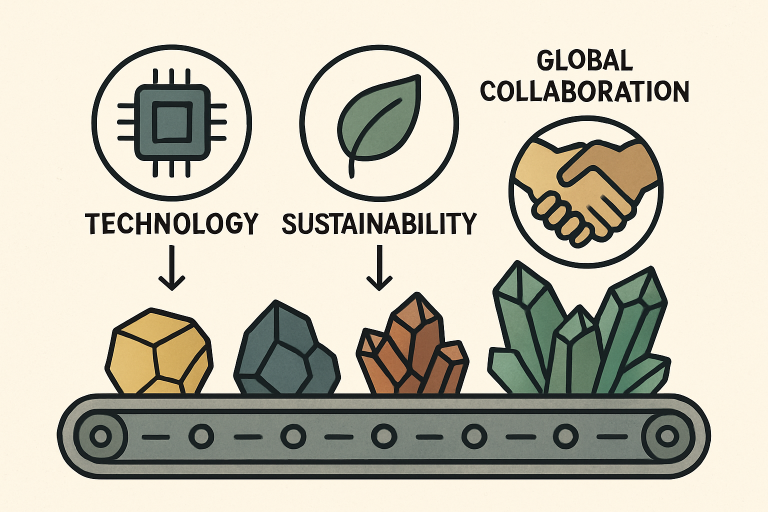The future of economic security and green technology depends heavily on reliable critical mineral supply chains. As the demand for rare earth elements and essential minerals continues to surge, the global mining sector is pivoting towards innovative solutions that address both environmental responsibility and supply stability. With the rapid adoption of clean energy technologies, companies like Ore Metals are at the forefront of changing how minerals are sourced and distributed, collaborating with partners to ensure a more sustainable future.
Supply chain disruptions, ongoing geopolitical tensions, and the urgent need for sustainable practices have prompted industries and governments to explore bold new strategies. The critical mineral sector is particularly dynamic, as it involves high-stakes decisions impacting everything from electric vehicle batteries to wind turbines, semiconductors, and medical devices. Navigating these challenges requires not only technical innovation but also collaborative efforts to break down bottlenecks and ensure access to essential resources worldwide.
Menu list
Emerging Technologies in Mineral Extraction
Innovation in mineral extraction technology is rapidly transforming the mining landscape. Cutting-edge advancements in low-emission, high-efficiency rare earth magnet recycling are revolutionizing traditional extraction processes. By adopting methods such as hydrometallurgical extraction and direct electro-winning, mining companies are minimizing environmental impact while maximizing yield. These new approaches enhance extraction rates, minimize waste, and lay the groundwork for a circular economy in critical minerals.
Sustainable extraction also benefits from digitalization and real-time monitoring systems, which enable targeted extraction, reduced water consumption, and less overall disturbance to natural habitats. As a result, critical mineral pathways are being reimagined not just for efficiency, but for responsibility to both people and the planet.
Strategic Partnerships and Global Initiatives
The fragile nature of critical mineral supplies has prompted leading economies to forge strategic partnerships and international frameworks designed to diversify sources and mitigate risks. Notably, the United States, Australia, India, and Japan have formalized partnerships to collaborate on secure maritime trade routes and the sharing of critical minerals and rare earth resources. These alliances support not only economic resilience but also technological leadership in growing sectors like EVs and renewable energy.
Multi-country initiatives also enable knowledge sharing, shared investment in research, and the exchange of best practices for both the discovery and processing of minerals. By collectively investing in infrastructure and regulatory frameworks, these global partnerships ensure that supply chains are less susceptible to disruption and market manipulation.
Government Investments in Critical Minerals
Recognizing the vital role of domestic mineral capacity, governments are ramping up financial support to reduce foreign dependency. In the United States, the Department of Defense’s $10 million grant to Elk Creek Resources stands as a testament to national priorities—specifically in establishing a secure supply of scandium sourced from Nebraska. This is part of a broader initiative encompassing grants, tax incentives, and public-private research programs aimed at accelerating domestic mining, refining, and recycling capabilities.
Countries including Canada, Australia, and members of the European Union are rolling out similar investments, each seeking to create robust and localized value chains. These efforts are not just about resource nationalism—they also feature strong traceability and environmental standards, positioning domestic suppliers for leadership in the global critical minerals race.
Recycling as a Sustainable Solution
As the lifecycle of modern technology shortens, the importance of recycling critical minerals is rapidly increasing. Technological advancements now allow companies to recover rare earth magnets and other essential materials from recycled electronics, wind turbine blades, and electric vehicle batteries, mitigating the need for virgin raw material extraction. This closed-loop approach lessens landfill waste and creates a secondary source stream to bolster overall supply chain resilience.
Scaling up recycling operations, however, requires streamlined logistics and supportive policy frameworks. Governments and corporations can play a pivotal role by incentivizing collection programs, supporting secondary recovery research, and establishing standards for end-of-life management.
AI and Digital Scanning in Exploration
Leveraging artificial intelligence and advanced digital scanning technologies is unlocking new frontiers in mineral exploration. Through AI-based analysis of geological data and the digitization of historic drilling cores, stakeholders can more accurately predict the locations of critical mineral deposits. Canada’s partnership with the Northwest Territories serves as a model, utilizing automated core scanning to identify new areas of high mineral potential without requiring additional invasive exploration.
These advances are beneficial for optimizing exploration efficiency, reducing discovery costs, and minimizing the environmental footprint of traditional prospecting. With machine learning algorithms, companies can process large datasets faster and more accurately than ever before, thereby accelerating the timeline from discovery to development.
Policy Approaches to Supply Chain Resilience
Policymakers are taking proactive steps to insulate critical mineral supply chains from external shocks. The European Union’s Critical Raw Materials Act is a leading example, setting ambitious targets for the domestic extraction, processing, and recycling of key materials. These regulations are complemented by risk assessment protocols, mandatory stockpiling, and strategic reserves to buffer against future shortages.
Other nations are adopting similar strategies, combining economic incentives with stringent environmental and transparency standards. By encouraging greater domestic self-sufficiency alongside international collaboration, these policies aim to build supply chains that are not only secure but also future-proof against market fluctuations.
Challenges and Future Outlook
The transition to resilient and sustainable critical mineral supply chains presents significant hurdles. Ongoing environmental concerns, from water usage to biodiversity loss, must be balanced with growing industrial demand. In addition, the international landscape is complicated by shifting alliances, trade barriers, and regulatory uncertainty.
Despite these challenges, the trajectory is one of cautious optimism. Ongoing advancements in extraction, recycling, and exploration technologies, combined with forward-thinking policies and robust international cooperation, are laying the foundation for a secure and sustainable future. The continued evolution of the critical minerals industry will shape not only economic policy but also global progress toward climate goals and technological innovation.
Conclusion
As global industries accelerate toward cleaner energy and advanced technologies, the importance of resilient critical mineral supply chains has never been more apparent. The combined force of emerging extraction technologies, strengthened international partnerships, expanded government investments, and innovative recycling initiatives is reshaping how the world discovers, processes, and secures essential materials. While challenges remain—from environmental concerns to geopolitical uncertainties—the momentum toward more innovative, more sustainable mineral pathways is unmistakable. By continuing to invest in innovation and cooperation, nations and industries worldwide can build a future where critical mineral supply chains are not only reliable but also aligned with the broader goals of economic stability and environmental responsibility.





